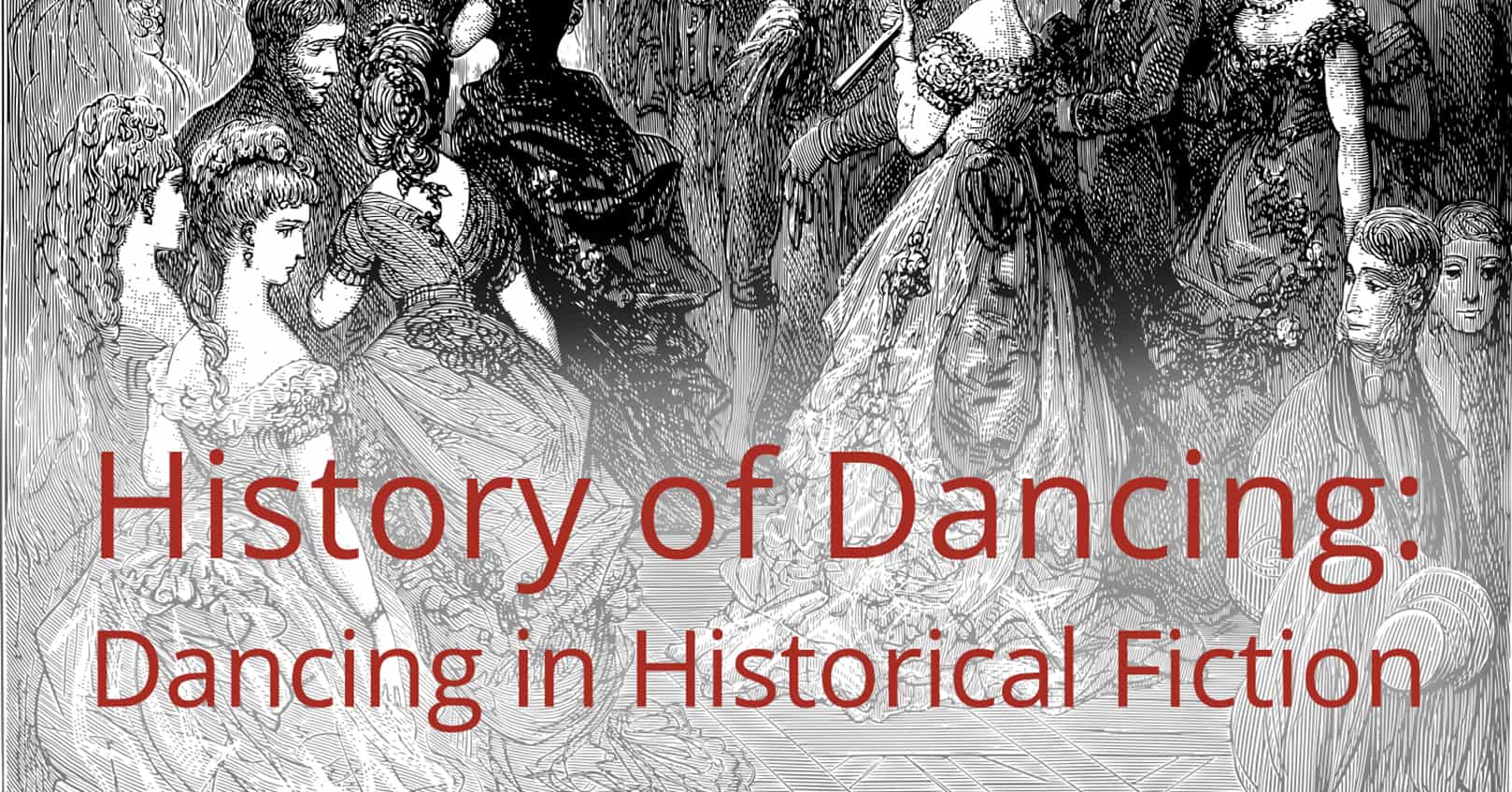
Dancing. It’s one of the fundamental things that societies do which helps define an era. Dancing in the 1960s does not look like dancing from the 1940s, or from the 1860s, or from the 1500s. While people in the United States don’t dance much today, for most of history, people danced. It was a social expectation. It was a form of celebration and personal expression. It was widely done, and any writer writing about the past is going to have to say something about the dancing their characters were doing.
Being a dance historian, a dance teacher, and an avid dancer, I find myself cringing all too frequently when writers take a stab at confronting dance. If you are doing your homework in order to get the clothing right, all you need to do is check a few old copies of Godey’s Ladies’ Book to see what the fashion plates were for 1865, or Harper’s Bazaar for 1965. Oh, look, they’re wearing hoopskirts, or miniskirts. But dancing is a much more complicated topic.
Depending upon the era being portrayed, there are hundreds of years of dance manuals documenting how to dance. Problem is, how easy are they to understand if you aren’t a dance historian? These books were also mostly written by dance teachers—how accurately are they depicting what people actually did? There’s a lot to be learned from the etiquette sections of these books. If there’s a section devoted to telling people NOT to look down the front of women’s dresses, you can be sure that’s because people were doing exactly that. (That’s just an example I made up, not something really from a manual. At least, not that I’ve discovered so far.)
Unfortunately, it takes a LOT of research to get this one right. That’s why Hollywood almost NEVER gets it right. No one wants to pay extra money for a dance historian to be the choreographer on a movie, and what choreographer has the time to do any homework to get the dancing right? Books usually get away with saying little, so as to be accurate by being as vague as possible. It still usually goes awry, but there’s only thousands of us out there, not millions of us, who know that the waltz in 1800 does not look like the waltz after 1844, which does not look like the Arthur Murray box waltz of the 1950s. And it did not exist before 1800.
For those of us who care about getting it right, here’s a rough guide to dancing in Western Civilization from the Renaissance to the present.
In the Renaissance, dancing was something done to entertain the king. Or queen. Or whoever The Presence was who threw the party. You were at an event thrown by someone higher in station than you, and here was an opportunity to please that person. The stakes were high. If the monarch liked the way you danced, you could be given the right to tax all the wine coming into your port city . . . and keep a full half of everything you collected! Or you could be married off to a very rich person and live in a castle or two.
What did these dances look like? For huge numbers of them, one man and one woman would perform lots of complicated footwork dancing next to each other while only touching fingertips. Or maybe entire hand contact. There were also dances done in circles that involved simpler footwork, but entertained by having bits of pantomime: pretending to be monks, or washerwomen, or horses.
There is a huge change in the nature of dance when John Playford starts publishing dance manuals in 1651. Besides footwork, more complicated figures involved four people dancing at one time . . . and you could be dancing without there being anyone to entertain but yourselves! This is revolutionary. Dancing is no longer something to do before royalty. It’s something everyone does for their own pleasure.
This is the birth of English country dancing. Earlier published dances tended to be for smaller groups, but over the next 100+ years, popular demand turned it into dances done in long lines. These are the dances Jane Austen describes, with very little detail because the readers she was writing for all knew how to do it. Having a conversation while waiting in the line until you had moved far enough up the set to be part of the dance was something all her readers had experienced.
But I am getting ahead of myself. Just because English country dancing was invented, doesn’t mean the concept of dancing before The Presence was instantly banished. The entire 18th century was a transitional period. While everyone loved the English country dances, there was still an expectation of performing for your social superiors—and for other guests at the same ball. The dance du jour: the minuet.
The minuet, like so many dances that preceded it in court ballrooms, was one man, one woman, minimal hand contact, and a lot of fancy footwork. (It has been described—not always unfairly—as very fancy walking.) The thing that really blows my mind about the minuet: it was done one couple at a time. It started with the highest-ranking person (male, I believe) in the room, who danced this short little two-minute dance. Then the next-highest ranking person and his partner of choice did the dance. Then the third-highest ranking person. This could (and did) go on for two hours. You had to watch everyone dance, take your turn dancing, and watch everyone else. And THEN everyone finally got the chance to do the popular country dances where everyone danced at once in long lines. Except for the new French Cotillions, which were done in squares of eight people.
Every dance is a reflection or reaction to what came before. The minuet was in ¾ time. This is what evolved into the waltz in 1800. Instead of walking past each other, two dancers positioned side by side, looking at each other while standing shoulder to shoulder, and did the fancy walking around each other with both of their right hands touching the side of their partner’s waist. You can see why this created such a scandal. Keep in mind this familiar touching happened concurrently with the fashions of 1800, when women were wearing skimpy muslin dresses that might very well have been misted down with water so the gents were dancing with a practically naked lady! Even worse, the revolving couple traveled clockwise around the room. So everyone in the room got to see the indecent spectacle up close.
The history of dance is the history of annoying your parents . . .
At the same time, the country dances were still popular, and that new invention of dancing in squares of eight people is definitely gaining in popularity! We’re calling them quadrilles now. The figures are mostly the same but the structure is a little different. Easier to remember.
The waltz as originally invented was kind of awkward to do, and required a fair amount of skill. It might have died a rapid death as a short-term dance fad. But then in 1844, a new dance came along and changed everything. It was called the Polka.
The real revolution (ha! That’s a pun, now) that polka brings to social dancing is the invention of ballroom position. It does not exist before this. The frame of two people facing each other with the gent’s hand on the lady’s waist, and their other hands joined is very stable. So stable, two partners can rotate clockwise around each other rapidly, galumphing counterclockwise around the entire ballroom at breakneck speeds.
This fun, easy dance travels from Bohemia, making it out to France. In Paris, college students cut classes to go polka dancing. The dance crosses the Channel to England. It crosses the ocean to the United States. Ballroom position gets retrofitted to the waltz, the Strauss family churns out one dance tune after another, and couple dancing is the wave of the future.
Just like before, it takes a while for the new dance to supplant the old one. But it does. In 1860, a ball program in the United States consisted mostly of quadrilles and set dances that bear a strong resemblance to English country dances, with some waltzes and polkas and other turning couple dances like schottische and mazurka thrown in. By 1900, a ball program mostly alternated between waltzes and a reconstituted polka called Two Step.
People get bored easily. And children simply cannot do the same dance that their parents did. Otherwise, how can they annoy their parents? The Turn of the Century featured waltz and Two Step sequence dances where everyone would know the same simple and repetitive choreography, and the whole room would do the same thing at the same time. There were dancing masters coming up with new, difficult ways to do fancy and challenging versions of all the couple dances. Society was ready for a change.
The next big dance revolution: Ragtime! The new music coming out of Tin Pan Alley demanded a new way of dancing to it. That new way was even more fun and simple than the polka: just walking. Not fancy walking like the minuet: just walking. As accessible as dancing can get. When you wanted to get fancy, you threw in some side steps and grapevines and pivots and such. It was called One Step.
Vernon and Irene Castle put a stylish edge to the new dance. Just because it was simple didn’t mean it wasn’t completely cool, and socially acceptable, to be dancing in each other’s arms without also rotating! Just as the Strauss family added fuel to the dance fires in the mid-1800s, Tin Pan Alley churned out dance tunes to fan the flames of the new dance craze, and made composers like Scott Joplin into household names.
The rate at which dances changed accelerated in the 1900s. In 1914, the doughboys in WWI were dancing the One Step, or doing it slowly and calling it tango. In the 1920s, the college boys and flapper girls were completely letting go of their partners altogether (the scandal!) and kicking up their legs in dances like Black Bottom and Charleston. Meanwhile, even the One Step had morphed into rhythmic patterns of quicks and slows called the foxtrot.
By the 1930s and 40s, those foxtrot rhythms stopped traveling. Dance floors were packed completely full and it was impossible to travel. Swing dancing didn’t require much room. Without all the traveling, the need for ballroom position relaxed into a light fingers-to-fingers grip that humorously resembles the handhold of 400 years ago. Except that’s the only resemblance. Facing your partner, now instead of needing the strong frame to turn together, what the leads do and what the follows do starts to look very different. Follows generally do a lot more turning, while the lead lifts a hand or gives a gentle push or tug to invite his partner to do the turning, without doing it himself.
The rock n’ roll dancing of the 1950s was different in such subtle ways, today’s swing dancers don’t even know the difference. And then Chubby Checker introduced The Twist.
There were solo fad dances before that. Of course it was less than 40 years since the Charleston had been popular, but dances like the Hucklebuck had also involved dancing without touching. But The Twist was the spark that ignited the flame that burned through all those Baby Boomer children.
There was The Pony, The Swim, The Hitchhiker, The Jerk, The Monkey, The Watusi, The Batman, The Mashed Potato, The Hully Gully, The Locomotion. They all involved standing in place, hopefully in the sand on the beach, and wriggling while gesticulating with your arms. All of them were pretty simple, kind of silly, and the music industry surpassed anything that came before in its ability to churn out new dance music. Instead of feeding the craze, they tried to invent the next new dance.
The funny thing is, it is not too far from those dances to the Lawn Sprinkler, the Shopping Cart, and the Flossing dances that I have seen in the last decade. We have had other dance crazes—disco in the 70s, and then break dancing and hip hop—but it seems like we are overdue for a new one. I would say TikTok is proof that people WANT to be dancing.
What historical fiction books have you read that have great dancing scenes? Let me know in the comments below!
Happy reading.














What a delightful read! I thoroughly enjoyed this short, but very informative article!